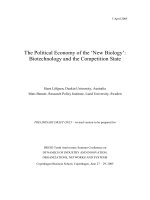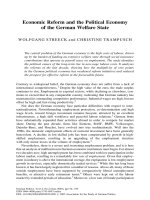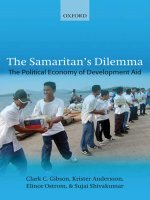the political economy of international trade
Bạn đang xem bản rút gọn của tài liệu. Xem và tải ngay bản đầy đủ của tài liệu tại đây (274.47 KB, 40 trang )
chapter
The Political Economy
of International Trade
McGraw-Hill/Irwin
Global Business Today, 5e
© 2008 The McGraw-Hill Companies, Inc., All Rights
Reserved.
6
6 - 3
Chapter 6: The Political Economy of
International Trade
INTRODUCTION
Free trade refers to a situation where a government does not attempt to restrict what its
citizens can buy from another country or what they can sell to another country.
While many nations are nominally committed to free trade, they tend to intervene in
international trade to protect the interests of politically important groups.
6 - 4
Chapter 6: The Political Economy of
International Trade
INSTRUMENTS OF TRADE POLICY
There are seven main instruments of trade policy:
•
Tariffs
•
Subsidies
•
Import quotas
•
Voluntary export restraints
•
Local content requirements
•
Antidumping policies
•
Administrative policies
6 - 5
Chapter 6: The Political Economy of
International Trade
Tariffs
A tariff is a tax levied on imports that effectively raises the cost of imported
products relative to domestic products.
•
Specific tariffs are levied as a fixed charge for each unit of a good imported
•
Ad valorem tariffs are levied as a proportion of the value of the imported
good
•
Tariffs increase government revenues, provide protection to domestic
producers against foreign competitors by increasing the cost of imported
foreign goods, and force consumers to pay more for certain imports
•
So, tariffs are unambiguously pro-producer and anti-consumer, and tariffs
reduce the overall efficiency of the world economy
6 - 6
Chapter 6: The Political Economy of
International Trade
Classroom Performance System
A tariff levied as a fixed charge for each unit of a good imported is a(n)
a) Fixed tariff
b) Specific tariff
c) Ad valorem tariff
d) Transit tariff
6 - 7
Chapter 6: The Political Economy of
International Trade
Subsidies
A subsidy is a government payment to a domestic producer.
Subsidies help domestic producers in two ways:
•
they help them compete against low-cost foreign imports
•
they help them gain export markets
Consumers typically absorb the costs of subsidies.
6 - 8
Chapter 6: The Political Economy of
International Trade
Import Quotas and Voluntary Export Restraints
An import quota is a direct restriction on the quantity of some good that may
be imported into a country.
•
tariff rate quotas are a hybrid of a quota and a tariff where a lower tariff is
applied to imports within the quota than to those over the quota
•
voluntary export restraints are quotas on trade imposed by the exporting
country, typically at the request of the importing country’s government
•
a quota rent is the extra profit that producers make when supply is
artificially limited by an import quota
•
import quotas and voluntary export restraints benefit domestic producers by
limiting import competition, but they raise the prices of imported goods
6 - 9
Chapter 6: The Political Economy of
International Trade
Local Content Requirements
A local content requirement demands that some specific fraction of a good
be produced domestically.
•
local content requirements benefit domestic producers, but consumers face
higher prices
Administrative Policies
Administrative trade polices are bureaucratic rules that are designed to make
it difficult for imports to enter a country.
•
these polices hurt consumers by denying access to possibly superior foreign
products
6 - 10
Chapter 6: The Political Economy of
International Trade
Antidumping Policies
Dumping is defined as selling goods in a foreign market below their costs of
production, or as selling goods in a foreign market at below their “fair” market
value.
•
Dumping is viewed as a method by which firms unload excess production in
foreign markets
•
Some dumping may be predatory behavior, with producers using substantial
profits from their home markets to subsidize prices in a foreign market with a
view to driving indigenous competitors out of that market, and later raising
prices and earning substantial profits
•
Antidumping polices (or countervailing duties) are designed to punish
foreign firms that engage in dumping and protect domestic producers from
“unfair” foreign competition
6 - 11
Chapter 6: The Political Economy of
International Trade
Classroom Performance System
A quota on trade imposed from the exporting country’s side is a(n)
a) Voluntary export restraint
b) Quota rent
c) Local content requirement
d) Administrative trade policy
6 - 12
Chapter 6: The Political Economy of
International Trade
THE CASE FOR GOVERNMENT INTERVENTION
There are two types of arguments for government intervention: political and economic.
•
Political arguments are concerned with protecting the interests of certain groups
within a nation (normally producers), often at the expense of other groups (normally
consumers)
•
Economic arguments are typically concerned with boosting the overall wealth of a
nation (to the benefit of all, both producers and consumers)
6 - 13
Chapter 6: The Political Economy of
International Trade
Political Arguments for Intervention
Political arguments for government intervention include:
•
protecting jobs
•
protecting industries deemed important for national security
•
retaliating to unfair foreign competition
•
protecting consumers from “dangerous” products
•
furthering the goals of foreign policy
•
protecting the human rights of individuals in exporting countries
6 - 14
Chapter 6: The Political Economy of
International Trade
Protecting Jobs and Industries
•
The most common political reason for trade restrictions is protecting jobs and
industries
•
Usually this results from political pressures by unions or industries that are
"threatened" by more efficient foreign producers, and have more political clout than the
consumers that will eventually pay the costs
6 - 15
Chapter 6: The Political Economy of
International Trade
National Security
•
Protecting industries such as aerospace or electronics because they are important for
national security is another argument for trade restrictions
Retaliation
•
When governments take, or threaten to take, specific actions, other countries may
remove trade barriers, however, if threatened governments don’t back down, tensions
can escalate and new trade barriers may be enacted
6 - 16
Chapter 6: The Political Economy of
International Trade
Protecting Consumers
•
Consumer protection can also be an argument for restricting imports
Furthering Foreign Policy Objectives
•
Trade policy can be used to support foreign policy objectives
•
Preferential trade terms can be granted to countries that a government wants
to build strong relations with
•
Trade policy can also been used to punish rogue states that do not abide by
international laws or norms (the U.S. has done this with Libya, Iran, Iraq,
North Korea, and Cuba)
•
However, it might cause other countries to undermine unilateral trade
sanctions
•
Two acts, the Helms-Burton Act and the D’Amato Act, have been passed to
protect American companies from such actions
6 - 17
Chapter 6: The Political Economy of
International Trade
Protecting Human Rights
•
Governments sometimes use trade policy to improve the human rights policies of
trading partners
•
Unless a large number of countries choose to take such action, however, it is unlikely
to prove successful
•
Some critics have argued that the best way to change the internal human rights of a
country is to engage it in international trade
•
The decision to grant China MFN status in 1999 was based on this philosophy
6 - 18
Chapter 6: The Political Economy of
International Trade
Economic Arguments for Intervention
The Infant Industry Argument
The infant industry argument suggests that an industry should be protected
until it can develop and be viable and competitive internationally.
•
The infant industry argument has been accepted as a justification for
temporary trade restrictions under the WTO
•
However, it can be difficult to gauge when an industry has grown up
•
Critics argue that if a country has the potential to develop a viable
competitive position its firms should be capable of raising necessary funds
without additional support from the government
6 - 19
Chapter 6: The Political Economy of
International Trade
Strategic Trade Policy
Strategic trade policy suggests that in cases where there may be important first mover
advantages, governments can help firms from their countries attain these advantages.
•
Strategic trade policy also suggests that governments can help firms overcome
barriers to entry into industries where foreign firms have an initial advantage
6 - 20
Chapter 6: The Political Economy of
International Trade
Classroom Performance System
Which argument for government intervention suggests that an industry should be
protected until it can develop and be viable and competitive internationally?
a) Strategic trade policy
b) National security
c) Retaliation
d) Infant industry
6 - 21
Chapter 6: The Political Economy of
International Trade
THE REVISED CASE FOR FREE TRADE
Two situations where restrictions on trade may be inappropriate: retaliation
and politics.
Retaliation and Trade War
•
Krugman argues that strategic trade policies aimed at establishing domestic
firms in a dominant position in a global industry are beggar-thy-neighbor
policies that boost national income at the expense of other countries
•
A country that attempts to use such policies will probably provoke
retaliation.
6 - 22
Chapter 6: The Political Economy of
International Trade
Domestic Politics
•
Since special interest groups can influence governments, Krugman argues that
strategic trade policy is almost certain to be captured by special interest groups within
an economy, who will distort it to their own ends
6 - 23
Chapter 6: The Political Economy of
International Trade
DEVELOPMENT OF THE GLOBAL TRADING SYSTEM
From Smith to the Great Depression
•
Up until the Great Depression of the 1930s, most countries had some degree of
protectionism
•
In 1930, the U.S. enacted the Smoot-Hawley tariff, which created significant import
tariffs on foreign goods
•
Other nations took similar steps and as the depression deepened, world trade fell
further
6 - 24
Chapter 6: The Political Economy of
International Trade
1947-79: GATT, Trade Liberalization, and Economic Growth
•
After WWII, the U.S. and other nations realized the value of freer trade, and
established the General Agreement on Tariffs and Trade (GATT)
•
The approach of GATT (a multilateral agreement to liberalize trade) was to gradually
eliminate barriers to trade
6 - 25
Chapter 6: The Political Economy of
International Trade
1980-1993: Protectionist Trends
•
During the 1980s and early 1990s, the world trading system was strained
•
Japan’s economic strength and huge trade surplus stressed what had been
more equal trading patterns, and Japan’s perceived protectionist (neo-
mercantilist) policies created intense political pressures in other countries
•
Persistent trade deficits by the U.S., the world’s largest economy, caused
significant economic problems for some industries and political problems for
the government
•
Many countries found that although limited by GATT from utilizing tariffs,
there were many other more subtle forms of intervention that had the same
effects and did not technically violate GATT (e.g. VERs)









